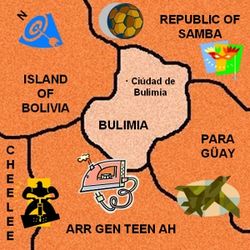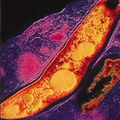Bulimia
República de Bulimia Bulimiaaaagghhh! aagh! aagh! Bulimia | |||||
|---|---|---|---|---|---|
| |||||
| Motto: No seas simia, practica bulimia! Don't be a monkey, practice bulimia! | |||||
| Anthem: The March of the Vomitteers | |||||
| Capital | Ciúdad de Bulímia | ||||
| Largest city | Ciúdad de Bulímia (the other ones don't qualify as cities) | ||||
| Official language(s) | Spanish, Vomiting, some German and Italian speakers | ||||
| Government | Banana Republic | ||||
| ‑ President | General Mathamisso Braveali | ||||
| ‑ Vice-President | General Diego Armando Umaparada Repúlsiva | ||||
| ‑ Prime Minister | General Alberto Repúlsiva | ||||
| Currency | Cucumber Peso | ||||
| Religion | Vomitism, Catholicism, Lutheranism | ||||
| Main products | Vomit and sausages | ||||
“Bulimia makes me want to throw up!”
– General Julio Roca, President of Argentina from 1880 to 1886, on Bulimia
Bulimia, officially the Republic of Bulimia (Spanish: República de Bulimia), is a South American country, bordered by Bolivia, Argentina, Paraguay and Brazil. There exists a wide misconception that Anorexia is Bulimia's eastern neighbour. This is not the case, as Anorexia is merely an autonomous demilitarized zone in the easternmost part of the Republic of Bulimia, bordering Brazil.
History and politics[edit | edit source]
Pre-Colombian Era[edit | edit source]
Today, little remains of the culture of the country's indigenous population which was supposed to be ethnically related to the To-Pee-Guaranis. Archaeological evidence suggests the Native Bulimians built a relatively large, albeit short-lived empire for a few weeks in the 13th century. Spanish archaeologists have recovered fragments of what appears to be a mural of a temple or a palace built during this short golden age in their excavations in the central plateau of the country. The mural depicts either a king or a high priest who eats fruit from a gigantic basket, then throws up and places his vomit on a plate apparently to an altar as an offering to the gods.
Spanish Conquest[edit | edit source]
Spanish explorers reached the plains of central Bulimia in the 1560's. They were struck by the abundance of edible fruit and berries, reportedly eating immense amounts at a time, after which they would throw up rather violently and messily.
Native Bulimians were soon converted to Catholicism by Spanish (and Portuguese, too) Jesuit missionaries who taught them the Spanish language and grouped them in religious farming communities called "Reducciones" ("Reductions") or, the places where they were reduced into serfdom to the Jesuits. The goal of the Jesuits was to have the Native-Bulimians make a living from selling wheat, corn and tomatoes to the silver and gold miners in Peru (so the Jesuits would be getting a lot of silver and gold from the miners at the expenses of the Native-Bulimian work) but the business ended up failing because the Native-Bulimians started using more and more of the production of the farms on their eating-and-vomiting rituals. The Jesuits figured the Native-Bulimians would never completely abandon their Pagan traditions and gave up trying to make them true Catholics, so they sold their lands to small Spanish farmers from the colony of Buenos Aires and left the country for good for forever. These Spanish-Argentine settlers not only introduced there the habit of eating and vomit Churrascos (barbecues) but also acquired the Native-Bulimian culture and began to grow cattle to be eaten and vomited with breads and tortillas.
Massacre of the Native-Bulimians by the Spanish settlers[edit | edit source]
Legends say that these Spanish-Argentine settlers in Bulimia had their first collective crisis of Bulimian Madness with a very gruesome outcome. It all began when they got all their crops and cattle eaten by the Native-Bulimians (who were having a crisis of Bulimian Madness themselves), and as these Spanish saw themselves doomed to starve to death, they resorted to eating the Native-Bulimians who stole their food since they found nothing else to eat. So they ate ridiculous numbers of Native-Bulimians in a few hours. Catholicism regards Cannibalism as a mortal sin though, and it made those Spanish-Argentine settlers feel very guilty and throw up. They threw up all the Indians they ate in their Bulimian Madness, and they kept throwing up for the rest of their lives every time they thought of what they did. Anyways, the Native-Bulimian Indians always discouraged cannibalism because they believed the eater would acquire the all the vices and bad habits of the eaten --which would explain why the Spanish settlers adopted so soon the Native-Bulimian eating-and-vomiting habit.
Independence and the Bulimian madness[edit | edit source]
In the early 19th century, Bulimia broke away from Spain together with other Latin American countries inspired by the revolutionary leaders Simon Bolivar and San Martin. Neither never visited Bulimia, though, due to its established negative reputation in the area. The Bulimian madness, as it was dubbed, was a well-known concept at that time already. It refers to the tendency of the Bulimians to eat too much, then feel guilty, and vomit.
Bulimia declared itself an independent republic on November 26, 1818. November 26 is the Bulimian national day. It involves a traditional banquet at the Presidential Palace in the capital, Ciudad de Bulimia. The semi-dictatorial President invites the country's leading politicians, businessmen, clergy, and artists to enjoy a huge 'Independence Dinner'. The next day, the visitors traditionally force themselves to vomit everything they have eaten.
Authoritarianism and the Cucumber Revolution[edit | edit source]
Bulimia soon turned to authoritarian rule. In 1866, due to the war the neighbour Republic of Paraguay got involved with Argentina, Brazil and Uruguay, the President General António López Repulsiva (himself a second-cousin of the Paraguayan dictator Francisco Solano Lopez) moved troops to the nearbies of the Brazilian and Argentine borders, declared State of Potential Foreign Threaten, Martial Law, suspended the Constitution and became Provisional Dictator until the end of the war involving the neighbouring countries; however, his provisional dictatorship lasted forever, and since then the republic has been led by the offspring of General Antonio Lopéz Repúlsiva. The President is the de facto ruler of the country, while the Prime Minister (most often the President's brother or son) is just a comedian performing at various night clubs on a regular basis, attempting to keep the populace content and amused. The so called "Cucumber Revolution" of 1972 deposed the Repúlsiva dynasty for a while. The opposition, which took the cucumber as its symbol, demanded more food to consume in a sudden frenzy of the Bulimian madness. Protesters waving cucumbers stormed the Presidential Palace in September, forcing President José Repúlsiva to flee the capital city. The angry out-of-control mob soon emptied the storehouses of the Presidential kitchen. The new republic turned out to be short-lived, however, as the protesters felt ashamed in a couple of hours, threw up, and returned home. The vomit-stained interiors of the Presidential Palace were cleaned and President Repúlsiva was back in control in two days.
Italian and German Immigration[edit | edit source]
Italian and German immigration began in 1874--after a personal decision of General António López Repulsiva in order to have a more varied menu of food in Bulimia--and lasted until about 1930. The introduction of Italian and German cuisines boosted the Bulimian National culture and the Bulimians began to vomit different kinds of German sausages such as the Dickwurst, the Schlongwurst, the Prickwurst and the Cockwurst as well as several Italian specialties such as spaghetti, rigatoni, tagliarini, capelletti, cannelloni, fettuccine, calzone and, obviously, lots and lots of pizza that made the happiness of the Bulimian nation.
The Bulimians also have an Oktoberfest, celebrated in the city of Bulimenau, where, every October, they drink thousands of gallons of beer to vomit it all afterwards.
Anorexia[edit | edit source]
After the defeat of Paraguay by Brazil, Uruguay and Argentina, the winner countries set an Anti-Bulimian government in Paraguay. In 1882, the new Paraguayan government, backed by Argentina, formally complained to Bulimia about their use of the Paraguay River as a vomit sewer and that the Paraguayans and Argentines could no longer stand the stink of the vomit delivered every day in the River Plate basin. The stinking waters that reached Buenos Aires were driving people sick to death there, and the President of Argentina, General Julio Roca, gave an ultimatum to the Bulimian government to stop using the Paraguay River as a sewer or Bulimia would be invaded by Argentina. Since then, the Bulimian government had to build immense ecological vomit processing plants, and the Province of Anorexia, in the easternmost part of Bulimia, by the river Paraguay, was turned into a demilitarized non-eating-and-vomiting area, which forced the people of Anorexia to quit eating at all so that they would not vomit any more. So the Anorexians began turning into living skeletons.
Modern Bulimia[edit | edit source]
The current Bulimian President, Gen. Alfonso Repúlsiva, has conducted some democratic reforms. However, Bulimia is still a somewhat isolated member of the international community. The country is not ignvited to international summits. UN officials say this is because Bulimian diplomats tend to eat too much and then throw up in the middle of a summit. An anonymous UN source says this has occurred "more than once". Bulimia has been kicked out 5 times for this.










